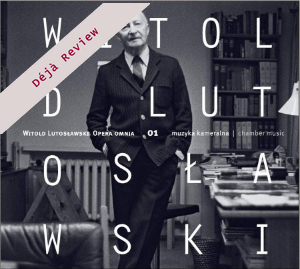Déjà Review: this review was first published in April 2009 and the recording is still available.

Witold Lutosławski (1913-1994)
Opera Omnia – Volume 1: The Chamber Music
Lutosławki Quartet Wrocław
Marcin Markowitz, Krzysztof Jakowicz, Jakub Jakowicz (violin)
Elzbieta Zawadzka, Jan Krysztof Broja (piano)
Artur Rozmyslowicz (viola)
rec. 2007, Lutosławski Concert Studio of Polish Radio, Warsaw
CD Accord ACD144-2 [73]
I had been wondering recently if Lutosławski’s music was disappearing from the horizon when his new CD landed heavily on the doormat.
As the extensive booklet essay points out, we think of Lutosławski primarily as a master magician for the orchestra. However, as these pieces show, chamber music ran like a thread throughout his life and is worthy of our undivided attention.
The String Quartet is the longest and most significant work here. It was written at a time when the composer was experimenting with form and notation. A little influenced by general avant-garde European developments, the scurrying sounds heard from time to time reminded me strongly of Ligeti, especially of his Second Quartet. Lutosławski favours a two-movement form with the opening nine minutes entitled ‘Introductory’ and the rest as ‘Main’ although they play without a break. The composer also used this successful and personal format in his Second Symphony of 1967 and in his Mi-Parti of 1976. Also to be found in this Quartet is his characteristic use of ’mobiles’ where the performers are given a freedom of rhythm based around certain pitches. The composer wanted not to use bar-lines in this work although that proved mostly to be unrealistic. These improvisatory sections are divided by a randomly placed and rather gruff unison passage in the first movement and a cello motif in the second. The work is fascinating but remains less than ingratiating.
The second longest piece on the disc is the five movement Partita in this version for violin and piano. There is another version brilliantly orchestrated and dedicated to Anne-Sophie Mutter which also has a major piano role. Later, that work was complemented by Chain 2 – also written for Mutter and serving as a fine follow-up. In reality Partita is a three movement piece with the initial two sections making a first movement then a Largo second movement to stand alone followed by an ad libitum and a Presto which serves as the final section. This latter bursts with accumulated energy and makes a great contrast with the cantabile Largo which precedes it. In this later music all is notated and there are even hints of the baroque.
But in all of this it is possible to forget that the root of Lutosławski’s music lies in the folk melodies of his native eastern European soil. These are encapsulated in the music of his first love: Bela Bartók. Several works on this disc allow us an insight into this attachment. In the forties and fifties composers were expected to toe the party line and write music which was immediately acceptable to the masses. These pieces are written with a real love and understanding. Bucolics for example even sounds like Bartók. It comprises arrangements of tunes from the Kurpie region drawn from the same selection of tunes used by Szymanowski in his Kurpian Songs. Bucolics is all done and dusted very quickly: you dance and you weep and you whistle. This is helped by an exceedingly spirited performance which gives great joy and delight. The aphoristic Four Silesian melodies likewise fit this profile and remind us of the composer’s own early orchestral song success the Silesian Triptych of 1951.
The brief Recitative and Arioso says quite a lot in its less than four minutes duration. Oddly enough you might think from the title that this a bi-partite structure. In fact the recitative makes an appearance at the end and gives a ternary feel to the piece. Again its modal ambience gives it a warm folk-inspired feeling but with a somewhat troubled outlook even if it is smiling through the tears.
Grave – Metamorphosis is a brief, impassioned and at times angry peroration in memory of a close friend of the composer. It grinds its way to a powerful climax before fizzling out. Bauer and Broja play it superbly: very moving. Incidentally, all of these wonderful performances are aided by one of the best recordings of chamber music I have heard for a long time. It is immediate but not overpowering and is superbly balanced.
The remaining pieces are also miniatures. Subito, written as a brilliant competition piece, is Lutosławski’s last work. The Sacher-Variation (note the singular) was composed around the letters of the conductor Paul Sacher’s name. Yet to describe these as miniatures gives the wrong impression. In their brevity they pack a strong emotional punch and are, like pearls, perfectly formed.
There are extensive performer biographies and photographs in the heavy but beautifully presented booklet. The useful essay is by Anna Kaspsyk and it’s nicely translated.
As I have said, these performance are terrific and very committed. The disc bodes well for the series as a whole. Naxos recorded all of Lutosławski’s orchestral works however a complete edition of Lutosławski’s music is much needed. This disc makes a brilliant start.
Gary Higginson
Help us financially by purchasing from


Contents
String Quartet (1964)
Recitativo and Arioso for violin and piano
Bucolics for viola and cello (c.1946)
Grave – Metamorphosis for cello and piano (1961)
Subito for violin and piano (5.07)
Sacher-variation for solo cello (1975)
Partita for violin and piano (1985)
Silesian Melodies for four violins Nos. 9-12 (1946-7)


















